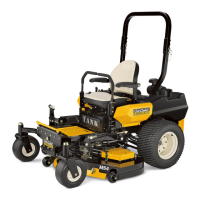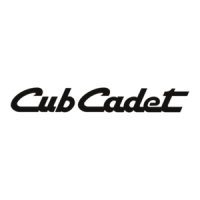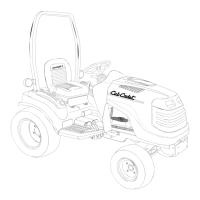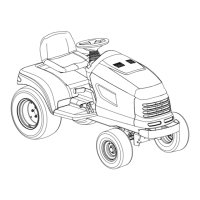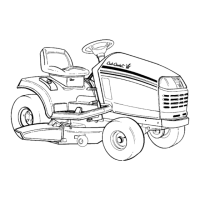7se c t i O n 2 — iM p O r t a n t sa f e Op e r a t i O n pr a c t i c e s
To avoid static discharge, keep the nozzle in contact d.
with the rim of the fuel tank or container opening
at all times until fueling is complete. Do not use a
nozzle lock-open device.
Extinguish all cigarettes, cigars, pipes and other e.
sources of ignition.
Never fuel machine indoors f. near an open flame,
spark or pilot light as on a water heater, space heater,
furnace, clothes dryer or other gas appliances.
If the fuelg. container spout will not fit inside the fuel
tank opening, use a funnel.
Never remove gas cap or add fuel while the engine h.
is hot or running. Allow engine to cool at least two
minutes before refueling.
i.
inch below bottom of filler neck to allow space for
fuel expansion.
Replace gasoline cap and tighten securely.j.
If gasoline is spilled, wipe it off the engine and k.
equipment. Move machine to another area. Wait 5
minutes before starting the engine.
To reduce fire hazards, keep machine free of grass, l.
leaves, or other debris build-up. Clean up oil or fuel
spillage and remove any fuel soaked debris.
Never operate/store the machine or fuel container m.
inside where there is an open flame, spark or pilot
light as on a water heater, space heater, furnace,
clothes dryer or other gas appliances.
Allow a machine to cool at least five minutes before n.
storing.
o.
to the engine and fuel system.
General Service
Never run an engine indoors or in a poorly ventilated area.
Engine exhaust contains carbon monoxide, an odorless,
and deadly gas.
2.
blade(s) and all moving parts have stopped. Disconnect the
spark plug wires and remove the key from the ignition to
prevent unintended starting.
complete stop within approximately (5) five seconds after
operating the blade disengagement control. If the blades
do not stop within the this time frame, your machine
should be serviced.
Regularly check the safety interlock system for proper 4.
function, as described later in this manual. If the safety
interlock system does not function properly, have your
machine serviced.
Check the blade(s) and engine mounting bolts at frequent 5.
intervals for proper tightness. Also, visually inspect blade(s)
for damage (e.g., excessive wear, bent, cracked). Replace
which do not meet the original equipment specifications
may lead to improper performance and compromise
safety!”
Mower blades are sharp. Wrap the blade or wear gloves, 6.
and use extra caution when servicing them.
Keep all nuts, bolts, and screws tight to be sure the 7.
equipment is in safe working condition.
Never tamper with the safety interlock system or other 8.
safety devices. Check their proper operation regularly.
After striking a foreign object, stop the engine, disconnect
the spark plug wire(s) and ground against the engine.
Thoroughly inspect the machine for any damage. Repair
the damage before starting and operating.
Never attempt to make adjustments or repairs to the
machine while the engine is running.
subject to wear and damage which could expose moving
parts or allow objects to be thrown. For safety protection,
frequently check components and replace immediately
listed in this manual. “Use of parts which do not meet the
original equipment specifications may lead to improper
performance and compromise safety!”
Do not change the engine governor settings or over-speed
the engine. The governor controls the maximum safe
operating speed of the engine.
Maintain or replace safety and instruction labels, as
necessary.
etc. to protect the environment.
Do not modify engine
To avoid serious injury or death, do not modify engine in any
way. Tampering with the governor setting can lead to a runaway
engine and cause it to operate at unsafe speeds. Never tamper
with factory setting of engine governor.
Notice Regarding Emissions
Engines which are certified to comply with California and federal
are certified to operate on regular unleaded gasoline, and
may include the following emission control systems: Engine
Modification (EM) and Three Way Catalyst (TWC) if so equipped.
